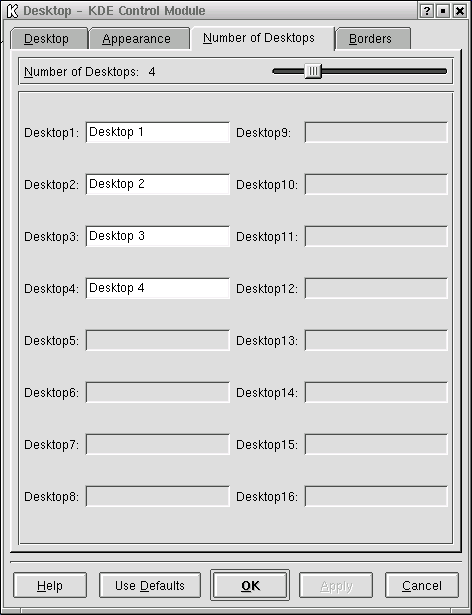The Panel
The panel stretches across the bottom of the desktop.
The panel is very configurable. You can add and remove applications and applets, which will allow you to access them easily. Right-click on the panel and select Settings to open the KPanel Control Module. Go to the General tab for panel placement and appearance options.
You can hide the panel by choosing to auto-hide it, making it appear to sink beneath the lower frame of your screen (it will return when you hold the cursor over the bottom edge of your screen). You can also hide the panel by clicking on one of the arrows on either of its borders.
Other tabs in the KPanel Control Module have options to further customize your panel. Click on Help for more information.
Applications and utilities can easily be added to the panel. To add an application to the panel, right-click on the panel and go to Add. Then select Button, Applet, or Extension and make your choice from the corresponding menu. Once your choice is highlighted, release the mouse button and the item will be added to the panel.
Multiple Desktops
By default, KDE provides four desktops on which you can spread your work. Each desktop can hold icons, open applications, and have individually customized backgrounds.
For example, while you're writing email on the first desktop, you can have Netscape Navigator running on desktop two, a word processor open on desktop three, and so on.
You can change the number and names of desktops available in KDE. To make these adjustments:
Right-click on the desktop; you'll see a limited menu of actions you can take.
Select Configure Desktop; the KDE panel configuration tool will open.
Click on the Number of Desktops tab (see Figure 3-6).
To change the names of your desktops, from One, Two, and so on, replace the default names with your preferred names in the appropriate boxes (see Figure 3-6).
You can increase (or decrease) the number of desktops available to you by adjusting the Visible slider of the Desktops dialog. For more desktops, drag the bar to the right; for fewer desktops, drag the bar to the left. The Desktop, Appearance, and Borders tabs are where you can make various desktop configuration selections, like icon arrangement and font size.
Buttons for your desktops appear on the panel in the Desktop Pager. Click on the buttons to move among your desktops. Alternately, you can use the Windowlist applet to navigate your desktops. If the Windowlist icon is not on your panel, you can add it by right-clicking on the panel and selecting Add => Windowlist.
 | Switch Desktops Quickly |
|---|---|
You can use the keyboard combination of the |

